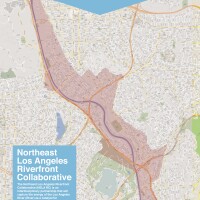Goal 7: Make Space for Social Equity

Equitable development is the creation of socially, culturally, ethnically, and economically diverse communities that are stable over the long term, through means that generate minimum transit costs for lower income residents. In order to ensure that community and economic development in NELA is fair and inclusive, we must make space for social equity.
Swaths of urban Los Angeles that are proximal to its original core have been experiencing rapid changes. From Downtown to residential neighborhoods, such as Echo Park, Silver Lake, or Hollywood, there is no question that new investment and development patterns have created physical and social change. Northeast Los Angeles and especially the neighborhoods adjacent to the River are no different.
In the past decade, real estate and capital speculation has intensified within the Study Area--resulting in tensions that center around themes of social equity.
Too often, the discussion of gentrification becomes polarized between the good and bad.
PolicyLink, a national non-profit research organization and technical assistance provider for the federal Partnership for Sustainable Communities grant programs, defines gentrification as ' the process by which higher income households displace lower income residents of a neighborhood, changing the essential character and flavor of that neighborhood.'
Gentrification should not be reduced to either good or bad. The impact of increasing values benefit existing residents and business owners who are property owners. We recommend strategies that will address the adverse consequences of gentrification. One challenge is involuntary displacement that negatively impact long-term residents who would prefer to stay but cannot afford to do so because of non-just cause evictions, rapidly rising rents, or increases in property tax bills. If development is to be equitable and if revitalization is to benefit both existing and future stakeholders, it is important to highlight the various tensions that arise and plan accordingly. The following objectives are shaped by concerns raised through the year long community engagement process.

Objectives
A. The Riverfront communities provide a certain amount of affordable housing today. It is not uncommon to meet households who have rented from family members for decades. Many households also benefit from the rent limits resulting from the Rent Stabilization Ordinance. However, many households will face upward occupancy cost pressures once higher or new land uses are proposed along the River and as these communities become a more desirable place to live.
Gentrification is potentially the most serious political issue associated with riverfront development. Its effects, both positive and negative, should be anticipated and mitigated with policy changes and program initiatives. A core issue related to rising values is the ability for long term renting households to access affordable housing, including rent stabilized and non stabilized housing and homeownership opportunities. By minimizing displacement of low-income families, the social, cultural, and economic diversity prevalent in these communities remain intact. Strategies range from creating a comprehensive housing policy (including affordable housing preservation, creation, and homeownership), partnering with community-based development organizations and the City's Housing & Community Investment Department, and establishing socially equitable community benefits agreements, or any other measures that address the potential for existing residents to benefit from River-related revitalization efforts.

B. As land values increase, small businesses - especially local 'mom and pop' shops are vulnerable to displacement because of increasing rental costs or inability to also cater to the changing demographics. Many of these small businesses also hire local stakeholders, providing a unique sense of community. Similarly, as industries expand or permanent jobs are created through development, the preparation of local stakeholders to enter and keep up with workforce needs ensures that NELA stakeholders can benefit from the positive impacts that are created through revitalization.
The social equity element of this objective is focused on supporting the most vulnerable populations - small businesses in the face of increasing competition and a workforce that faces higher barriers to employment, such as local youth and young adults. It will be essential to provide additional support services to small businesses and target workforce development programs to NELA stakeholders with a focus on quality jobs in high growth and living wage sectors
C. Economic development, gentrification, and revitalization can often be demonized as practices that are driven by outsiders. This does not need to be the case. A social equity driven model, like the one proposed by PolicyLink, can create a process that values local community and works in partnership to facilitate growth that meets both development opportunities and community needs. This type of co-development will require the creation of sustainable community organization and communication infrastructure that engages the full range of stakeholders, especially those who find traditional methods of civic engagement unfamiliar or ineffective.
As a region, the NELA community lacks a local development organization with a strong and sustainable community organizing approach for the future development of the region. Effective community organizing in this area will require a focus on the recruitment and education of local leaders, as well as innovative methods for in the engagement of lower-income communities that are vulnerable to displacement. Examples of Los Angeles community organizations with strong community organizing programs focused on development are East Los Angeles Community Corporation, T.R.U.S.T. South L.A., and Southeast Asian Community Association.


